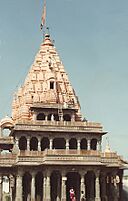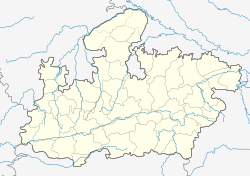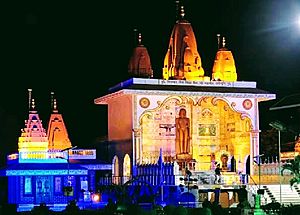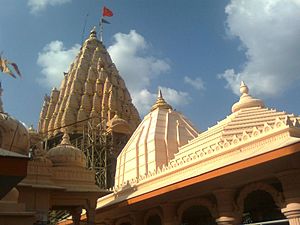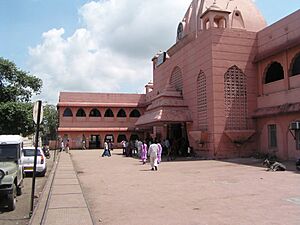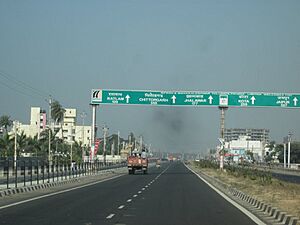Ujjain facts for kids
Quick facts for kids
Ujjain
Ujjayinī / Avantikā
|
|
|---|---|
|
City
|
|
|
Ram Ghat
Mahakaleshwar Temple
Tower Chowk
Shipra River
Deepmalika
|
|
| Nickname(s):
The City of Temples
|
|
| Country | |
| State | |
| Region | Malwa |
| District | Ujjain |
| Government | |
| • Type | Municipal corporation |
| • Body | Ujjain Municipal Corporation |
| Area | |
| • City | 151.83 km2 (58.62 sq mi) |
| • Metro | 745 km2 (288 sq mi) |
| Area rank | 5th in M.P. |
| Elevation | 494 m (1,621 ft) |
| Population
(2011)
|
|
| • City | 515,215 |
| • Rank | 5th in M.P. |
| • Density | 3,393.37/km2 (8,788.78/sq mi) |
| • Metro | 885,566 |
| Languages | |
| • Official | Hindi |
| • Other | Malvi |
| Time zone | UTC+5:30 (IST) |
| PIN |
456001, 456003, 456006, 456010, 456661, 456664.
|
| Telephone code | 0734 |
| Vehicle registration | MP-13 |
| Climate | Cwa (Köppen) |
| Precipitation | 900 millimetres (35 in) |
| Avg. annual temperature | 24.0 °C (75.2 °F) |
| Avg. summer temperature | 31 °C (88 °F) |
| Avg. winter temperature | 17 °C (63 °F) |
Ujjain is an important city in the state of Madhya Pradesh, India. It is also known by its old names, Avantika or Ujjayinī. Ujjain is the fifth-largest city in Madhya Pradesh. It is a major center for the Ujjain district.
This city is famous as one of the seven holy places for Hindus, called Sapta Puri. Every 12 years, a huge festival called the Kumbh Mela ((Simhastha)) takes place here. The famous Mahakaleshwar Jyotirlinga temple is right in the middle of the city.
Ujjain has been a very important trading and political hub in India for a long time. This goes all the way back to ancient times, even before the British came. The city sits on the eastern bank of the Shipra River. It was the most important city on the Malwa plateau for much of its history.
Around 600 BCE, Ujjain became the main political center of central India. It was the capital of the ancient Avanti kingdom. In the 18th century, Ujjain was briefly the capital of the Scindia Dynasty of the Maratha Empire. This happened when Ranoji Scindia made it his capital in 1731.
Ujjain remained a key city for politics, business, and culture until the early 1800s. Then, the British decided to develop Indore instead. Today, Ujjain is still a very important place for pilgrims. People who follow Shaivite, Vaishnavite, and Shaktas religions visit here.
Many believe that bathing in the holy Shipra river in Ujjain can wash away sins. This is why Ujjain is also called the 'Mokshadayini city', meaning 'city that grants freedom'. The Shipra river is considered as holy as other famous rivers like Kaveri, Narmada, Godavari, and Krishna.
An old story says that Ujjain is one of four places where drops of amrita, the drink of immortality, spilled. This happened by accident from a kumbha (pitcher) carried by the bird Garuda. It occurred during the Samudra Manthana, which was the churning of the ocean of milk.
Ujjain is also one of the 100 Indian cities chosen to become a smart city. This is part of Prime Minister Narendra Modi's Smart Cities Mission.
Contents
History of Ujjain
Early Settlements and Ancient Times
Scientists have found signs of old farming villages near Ujjain. These date back to around 2000 BCE. But, no such early settlements have been found in Ujjain itself. Some experts think that later settlers from the Iron Age might have destroyed them.
Around 700 BCE, Ujjain began to grow into a city. By 600 BCE, it was a major center for politics, trade, and culture in the Malwa region. The ancient city of Ujjain had strong walls. It was located near the Garh Kalika hill, by the Kshipra river. This old city was surrounded by a 12-meter-high mud wall. It also had a wide, deep ditch around it for protection. These defenses were built between the 6th and 4th centuries BCE. During this time, people used stone and burnt bricks for buildings. They also used iron tools and weapons.
Ujjain in the Mauryan Empire
In the 4th century BCE, the Mauryan emperor Chandragupta Maurya added Avanti, with Ujjain as its capital, to his empire. His grandson, Ashoka, was a viceroy (like a governor) of Ujjain. This shows how important the city was. While in Ujjain, Ashoka married Devi, a merchant's daughter. Their children, Mahendra and Sanghamitra, were born in Ujjain. They later helped spread Buddhism in Sri Lanka.
From the Mauryan period, archaeologists have found old pottery, copper coins, and ivory seals in Ujjain. Ujjain became an important trading city. This was partly because it was on a trade route connecting north India to the Deccan region. It also became a center for learning for Jain, Buddhist, and Hindu traditions.
After the Mauryans, different empires ruled Ujjain. These included the Shungas, the Western Satraps, the Satavahanas, and the Guptas. Ujjain was a key city for the Guptas in the 4th and 5th centuries. Kalidasa, a famous Indian poet from the 5th century, lived during the time of the Gupta king Vikramaditya. Kalidasa wrote about the beauty and richness of Ujjain in his work Meghadūta.
Many ancient Indian stories and plays are set in Ujjain. The great writer Bhartṛhari is said to have written some of his works here. The plays of Bhasa and Mrichchhakatika by Shudraka also take place in Ujjain. The city is often mentioned as the capital of the legendary emperor Vikramaditya. An 11th-century text describes Ujjain as a strong, rich city full of amazing sights. In the 8th century CE, the city was attacked by Arabs. They called the city Uzayn.
Ujjain in the Medieval Period

The Paramaras ruled Ujjain from the 9th to the 14th century. They later moved their capital from Ujjain to Dhar. In 1235 CE, Iltutmish of the Delhi Sultanate took over the city. After this, Ujjain came under Islamic rule, like many other parts of central India.
Ujjain remained an important city. Even during the time of the Mughal ruler Jai Singh II (1688-1743), it was the largest city and capital of the Malwa region. Jai Singh II built an observatory, called a Jantar Mantar, in Ujjain. The city continued to grow under Muslim rule, especially during the Delhi Sultanate and the Mughal Empire. It was used as an important military base.
Ujjain in Modern Times
In the 18th century, Ujjain briefly became the capital of the Scindia state of the Maratha Empire. This happened when Ranoji Scindia made it his capital in 1731. A grand palace was built, and many temples were restored or newly built. However, later rulers moved their capital to Gwalior.
There was a rivalry between the Holkars of Indore and the Scindias of Ujjain. In 1801, the Holkars defeated the Scindias in the Battle of Ujjain. Later, the British decided to develop Indore instead of Ujjain. This was because Ujjain's merchants had supported people against the British. After India became independent, Ujjain became part of the Madhya Bharat state. This state then joined Madhya Pradesh in 1956.
Geography and Climate of Ujjain
Where is Ujjain Located?
Ujjain is in the west-central part of India. It is located on the Malwa plateau, which is higher than the plains of north India. The land rises towards the Vindhya Range in the south. Ujjain is about 494 meters (1620 feet) above sea level. The city is on the bank of the Shipra River, which flows into the nearby Chambal.
Ujjain is about 57 km (35 miles) from Indore. It is also 40 km (25 miles) from Dewas and 197 km (122 miles) from the state capital, Bhopal.
What is Ujjain's Climate Like?
Ujjain has a humid subtropical climate. This means it has hot summers, a rainy monsoon season, and cool, dry winters.
- Summers: They usually start in mid-March and last until late June. Temperatures can reach up to 45 °C (113 °F). May is usually the hottest month.
- Monsoons: The rainy season begins in late June and ends in late September. Ujjain gets about 914 mm (36 inches) of rain during these months. There are often thunderstorms and sometimes floods. The average temperature is around 24 °C (76 °F).
- Winters: Winters are from early November to early March. They are cool, dry, and sunny. Sometimes, temperatures can drop close to freezing (0-3 °C or 32-37 °F). But usually, the weather is very pleasant, with an average daily temperature of about 16 °C (61 °F).
| Climate data for Ujjain (1991–2020, extremes 1954–2012) | |||||||||||||
|---|---|---|---|---|---|---|---|---|---|---|---|---|---|
| Month | Jan | Feb | Mar | Apr | May | Jun | Jul | Aug | Sep | Oct | Nov | Dec | Year |
| Record high °C (°F) | 34.6 (94.3) |
39.0 (102.2) |
42.5 (108.5) |
45.2 (113.4) |
46.0 (114.8) |
45.5 (113.9) |
41.1 (106.0) |
37.0 (98.6) |
39.8 (103.6) |
39.8 (103.6) |
36.6 (97.9) |
34.9 (94.8) |
46.0 (114.8) |
| Mean daily maximum °C (°F) | 26.4 (79.5) |
29.4 (84.9) |
34.9 (94.8) |
38.9 (102.0) |
40.9 (105.6) |
37.3 (99.1) |
31.0 (87.8) |
29.1 (84.4) |
31.5 (88.7) |
33.8 (92.8) |
30.9 (87.6) |
28.2 (82.8) |
32.5 (90.5) |
| Mean daily minimum °C (°F) | 8.7 (47.7) |
10.6 (51.1) |
14.8 (58.6) |
19.5 (67.1) |
24.8 (76.6) |
25.0 (77.0) |
23.2 (73.8) |
22.2 (72.0) |
21.4 (70.5) |
18.0 (64.4) |
13.7 (56.7) |
9.4 (48.9) |
17.4 (63.3) |
| Record low °C (°F) | 0.0 (32.0) |
1.0 (33.8) |
4.6 (40.3) |
10.1 (50.2) |
12.0 (53.6) |
18.7 (65.7) |
18.0 (64.4) |
16.5 (61.7) |
11.8 (53.2) |
8.1 (46.6) |
2.8 (37.0) |
0.5 (32.9) |
0.0 (32.0) |
| Average rainfall mm (inches) | 6.6 (0.26) |
2.9 (0.11) |
6.7 (0.26) |
2.4 (0.09) |
7.3 (0.29) |
113.5 (4.47) |
331.1 (13.04) |
249.7 (9.83) |
163.2 (6.43) |
26.8 (1.06) |
14.1 (0.56) |
4.6 (0.18) |
928.9 (36.57) |
| Average rainy days | 0.5 | 0.5 | 0.4 | 0.4 | 0.7 | 6.3 | 12.1 | 10.2 | 6.8 | 1.6 | 1.0 | 0.3 | 40.8 |
| Average relative humidity (%) (at 17:30 IST) | 40 | 31 | 24 | 20 | 22 | 42 | 68 | 76 | 64 | 42 | 40 | 41 | 42 |
| Source: India Meteorological Department | |||||||||||||
Ujjain has been ranked as the 26th best "National Clean Air City" in India. This is for cities with a population between 300,000 and 1 million.
People and Languages in Ujjain
In 2011, Ujjain had a population of 515,215 people. There were slightly more males than females. The city's literacy rate was high, at about 85.55%. This means most people can read and write.
| Religions in Ujjain City (2011) | ||||
|---|---|---|---|---|
| Religion | Percent | |||
| Hinduism | 77.51% | |||
| Islam | 18.88% | |||
| Jainism | 2.44% | |||
| Christianity | 0.51% | |||
| Other or not stated | 0.66% | |||
Hindi is the most spoken language in Ujjain. Since Ujjain is in the heart of the Malwa region, the Malvi language is also widely spoken.
Fun Things to See and Do in Ujjain
Ujjain is a city full of history and spiritual places. Here are some popular spots to visit:
- Mahakal Lok Corridor: A beautiful new corridor near the Mahakaleshwar temple.
- Mahakaleshwar Jyotirlinga: A very famous and important temple dedicated to Lord Shiva.
- Kal Bhairav Temple: Another significant temple known for its unique rituals.
- Sandipani Ashram: An ancient ashram (hermitage) where Lord Krishna is believed to have studied.
- Mangalnath Temple: A temple dedicated to Mars (Mangal), located on the banks of the Shipra River.
Learning and Education in Ujjain
Ujjain has many schools and colleges for students.
Universities in Ujjain
- Maharshi Panini Sanskrit University
- Vikram University
- Avantika University
Medical Colleges in Ujjain
- Ruxmaniben Deepchand Gardi Medical College
- Govt. Medical College
- Amaltas Medical College
Engineering Colleges in Ujjain
- Ujjain Engineering College (Government)
- School of Engineering Vikram University (Government)
- MIT Group of Institutes, Ujjain
- Shree Guru Sandipani Institute of Science and Technology
- Prashanti Institute of Technology
- Alpine Institute of Technology
Schools in Ujjain
- St. Paul's convent H.S. School
- Christu Jyoti Convent School
- Ujjain Public School
- Lokmanya Tilak Higher Secondary School, Ujjain
- St. Mary's Convent School
- Nirmala Convent School
- Takshshila Junior College
- Kalidas Montessori Sr. Sec. School
- Carmel Convent Sr. Sec. School
Industries and Jobs in Ujjain
The main industrial areas around Ujjain are 'Dewas Road Industrial Area', 'Maxi Road Industrial Area', 'Vikram Udhogpuri', and 'Tajpur Industrial Area'.
Nearby cities like Indore and Dewas have many industries. These provide jobs for people living in Ujjain and the surrounding areas. The Government of Madhya Pradesh is also developing a large industrial area near Narwar village. This area is called "Vikram Udyog Nagari" ("Vikram Industrial City"). It is planned to be both an industrial and educational hub.
Getting Around Ujjain
Air Travel to Ujjain
Ujjain does not have a large airport. It has a small airstrip on Dewas road for air transport. The closest major airport is the Devi Ahilyabai Holkar International Airport in Indore, which is about 57 km away.
Train Travel in Ujjain
Ujjain Junction is the main railway station in the city. It connects Ujjain to many major railway stations across India. It is on important routes like Indore–Dewas and Ratlam–Bhopal.
There are six railway stations in Ujjain city and its nearby areas:
| Station name | Station code | Railway zone | Total platforms |
|---|---|---|---|
|
Ujjain Junction
|
UJN | Western Railway | 08 |
|
Chintaman Ganesh
|
CNN | Western Railway | 03 |
|
Matana Buzurg
|
MABG | Western Railway | 02 |
|
Pingleshwar
|
PLW | Western Railway | 02 |
|
Vikramnagar
|
VRG | Western Railway | 03 |
|
Tajpur
|
TJP | Western Railway | 02 |
Road Travel in Ujjain
Ujjain has two main bus stands: Dewas Gate Stand and Nana Kheda Bus Stand. These provide bus services to many cities in different states. You can find buses to places like Ahmedabad, Jaipur, Indore, Bhopal, and Mumbai.
The city has a good road network. It includes roads like Indore Road, Dewas Road, and Nagda Road. There are also three national highways that pass through Ujjain.
Local Transport in Ujjain
For getting around within Ujjain, people use auto rickshaws, city buses, and private taxis. The Ujjain Municipal Corporation has recently started city bus services. This helps people travel easily throughout the city.
Sports and Fun in Ujjain
Cricket is a very popular sport in Ujjain. The city has the Ujjain Divisional Cricket Association. Ujjain has hosted some professional cricket matches in the past.
Kite flying is another popular activity, especially around the festival of Makar Sakranti.
Ujjain as a Smart City
Ujjain has been chosen as one of the cities to be developed under the Government of India's Smart Cities Mission. This project aims to make cities better with improved services like water supply, transport, and e-governance. The Ujjain Municipal Corporation is working with citizens to gather ideas for making Ujjain a "smart city."
Famous People from Ujjain
Many notable people were born or lived in Ujjain. Here are a few:
- Sage Sandipani
- Varāhamihira (a famous astronomer and mathematician)
- Bhāskara II (another great mathematician)
- Kālidāsa (a renowned classical Sanskrit writer)
- Devi (wife of Ashoka) (wife of Emperor Ashoka)
- Shivmangal Singh Suman (a famous poet)
- Shreeram Shankar Abhyankar (a well-known mathematician)
- Bharthari (a philosopher and poet)
- Vivian Dsena (an actor)
- Thawar Chand Gehlot (a politician)
- Naman Ojha (a cricketer)
- Saumya Tandon (an actress)
- Vikramaditya (a legendary emperor)
- Juhi Parmar (an actress)
- Mohan Yadav (a politician)
See also
 In Spanish: Ujjain para niños
In Spanish: Ujjain para niños



